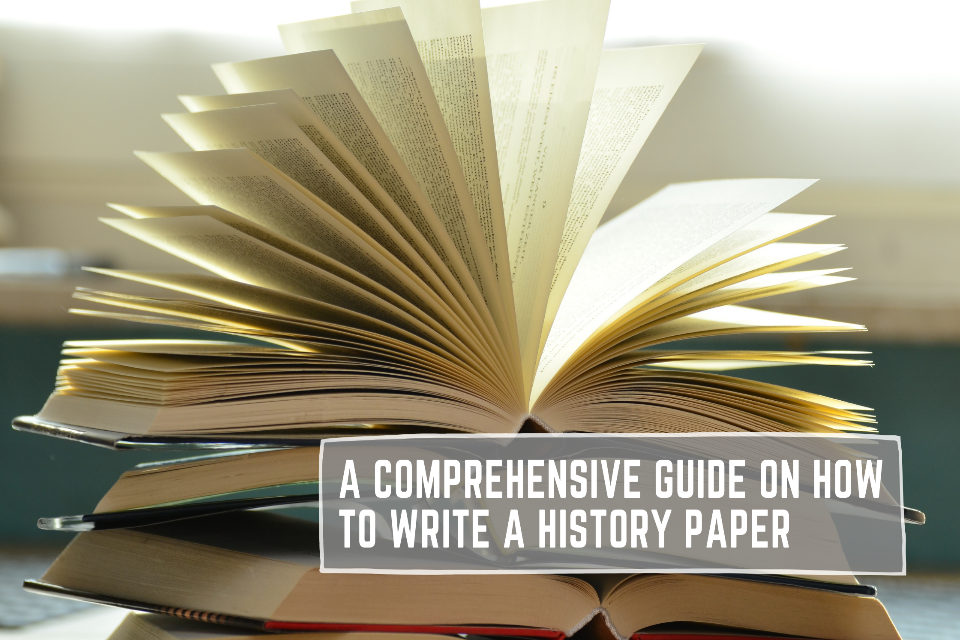A Comprehensive Guide on How to Write a History Paper

Do you want to learn how to write a history paper? Do you have any questions about the elements and regulations of writing a history paper? It is simple to learn how to write a history paper. Here are a few pointers for your help:
- Dates should be avoided. In writing, avoid using dates excessively when learning how to write a history paper. Why is it so? Because the criteria are quiet on this matter, yet you may receive a worse mark if you make errors. As a result, before precisely documenting the event’s year, date, and time, consider if you are sure of its accuracy. If not, don’t take the chance.
- It doesn’t have to be written beautifully. Beauty can be saved for literary writing, and you will not earn points for attractiveness in history papers. However, there must be a start, a culmination, and an explanation of the issue. As a result, we write clearly and understandably when learning how to write a history paper.
- Ensure not to write too much. Consider your professor: do you believe they want to read the lengthy material as if it were a textbook on global history? Of course, the professor does not want to. As a result, you only need to write what is specified in the specifications. Most of the time, the length is between 200 and 300 words.
- Have a plan in place. Make a short plan containing the characters, incidents, and repercussions you will pursue when drafting the paper before beginning. It is required for the text’s clarity and uniformity.
- Examine historians’ viewpoints. Your perspective is essential while learning how to write a history paper but citing reputable sources can help you earn a better grade. As a result, look up quotes from well-known historians on the subject.
History: The definition and its importance
History is a branch of academics that deals with human society’s development rules and patterns. It is critical to understand your country’s history and study international history when learning how to write a history paper. Let’s find out why history exists in the first place:
- To avoid making the same mistakes that past generations did. All unfavourable historical events should be thoroughly examined to avoid repeating past mistakes in the future. It will assist in steering contemporary life in the right way. Understanding history is crucial for considering past generations’ errors and avoiding them in the present.
- To have a better understanding of how different nations formed. It is the tale of how our nation and its neighbouring areas came to be. It is not only thrilling but also educational.
- Adapt to your circumstances. It’s not simple to come up with all of the ideas yourself. As a result, acquiring experience permits science, society, civilization, and arts to evolve. It isn’t easy to evaluate previous generations’ expertise. Nevertheless, its importance illustrates the significance of history for succeeding generations. Information gleaned from the past allows one to approach events with meaning, evaluate them, and integrate the data to make plans later based upon it.
The definition of a history paper
The next step of learning how to write a history paper is to understand it.
The style of writing project focuses on historical events, individuals, customs, and culture. Students are given many historical or contemporary themes to write about as a subject. These themes cover several periods in history and evaluate historical events or individuals.
The objective of the essay writer is to convey and defend his or her viewpoint on the chosen topic when learning how to write a history paper. Also, the author must depend on factual information and portray the perspectives of scholars utilizing information from reliable sources. The following characteristics may be found in the historical paper:
- Have a specific query or topic in mind. You can’t create a history paper that looks at various issues. The article’s topic must always be precise when learning how to write a history paper.
- The subjective aspect of the problem’s perception and comprehension. The paper is intriguing because it allows the reader to observe an individual, assess the novelty of his stance, the idiosyncrasies of his thoughts, worldview, and, finally, the writer’s writing style.
- The paper’s internal semantic coherence. It’s critical to keep two considerations in mind here. First, the history paper’s essential arguments and claims must be agreed upon. Second, there must be consistency in the debates.
The different types of history papers
The next step of understanding how to write a history paper is to understand its various types. These include:
- The study of particular situations or case studies entails selecting an issue, analyzing the status of its remedy, gathering information, applying statistical methodology and forming a hypothesis, employing facts, contrasting with different perspectives, and developing a conclusion.
- Like a paper on a specific theme, a creative work begins with a so-called conceptual introduction, preceded by a thematic statement developed via thematic instances and then reformulated.
- Comparative analysis is a type of written assignment. The written content reflects all advantages and disadvantages. Positive details can be accessed in the first portion of the text, whereas harmful content may be found in the latter. Positive and negative data can be mixed. You might write about a historical character and explain their good and bad qualities. For instance, describe the military operations if he’d been a combatant in war. If he had been to lead the nation, list the benefits and drawbacks.
- Story writing holds a distinct position within creative writing jobs. Students may be presented with questions to which they must respond to create a tale.
History paper sources
If they are chosen appropriately, gathering sources for history papers is half of the battle for academic accomplishment. Around 60% of pupils can pick sources accurately. However, 40% of people had a hard time answering this problem. We will make every effort to ensure that you clearly understand the challenges of locating the appropriate sources when learning how to write a history paper.
A source is essentially a record utilized to comprehend current and past events in history. A record can no longer be regarded as a historical reference if it contains historical facts to some extent but is formally acknowledged as not being part of history.
Visiting an online library is one of the most effective ways to find resources when learning how to write a history paper. To locate publications by other writers, type in the topic of your work. A collection of papers, publications, summaries, research papers, and doctoral dissertations will be sent to you. It’s a good idea to get acquainted with these options.
The next stage of learning how to write a history paper is to acquaint oneself with the bibliography offered in an influential term paper or dissertation, which will help you choose intriguing resources. A list of references is included in every abstract, paper, article, or other scientific publication. You can learn about the sources that another author used.
Keep in mind that you should retain essential resources on your computer. You won’t be able to recall all the items you’ve read on the web. Likewise, having an overview with basic details about any resources makes more sense. We also recommend that you take college history classes when learning how to write a history paper since professors may occasionally provide valuable references for drafting an article.
How to use evidence when learning how to write a research paper?
Students who are learning how to write a history paper for the first time sometimes confuse proof with the simple appearance of citation sources. The sources are provided merely to show that you researched the material and relied on the comments of the authorized experts. However, using historical sources as proof to build a historical case is not beneficial. To obtain evidence, surveys must be conducted, interviews with historians must be conducted, questions must be properly asked, and reasoning must be founded on the facts. Personal anecdotes can also be used to justify the claim. If you don’t have time to gather facts, you may rely on information resources, but ask yourself some basic questions.
Who
Use only reliable sources while gathering proof. Who is the writer, you might wonder? What did the writer use to create the paper? Is the author’s own experience reflected in the document? Was the author prejudiced or deceptive when drafting the text?
Has the structure of the paper been logically formed?
When
Further, while picking sources, inquire when the source was produced. When, where, and in what conditions? Were there any similar reports coming out about the same time I was drafting the paper? Why was the paper written during this period? What variables impacted the text’s creation?
Why
When selecting a source for verifying terms, consider why the writer created this information resource. What was the objective of the paragraph that he chose and included? Who is the target audience for such data? Is the writer’s objective in work in line with your own? Is the material available for public viewing, or can it be purchased from an online library?
How
The final thing you should think about is how the source fits into your content. Is the material unique in terms of originality and intriguing information? Is the information unique compared to the other sources you’ve looked at? Is it possible to make this source the main focus of your paper? Is the author’s point of view communicated effectively in writing? Is there enough proof in the text to support your claim? Is the data well-organized? Is the material explicit about the periods, location, participants, and occurrences?
A Step-by-Step Guide to Writing History
Composing a history piece is, though, especially when learning how to write a history paper. However, we have compiled a comprehensive guide on how to write a history paper for you. We’d also want to inform you that writing a history paper is a necessary task that needs a significant amount of time and energy and is challenging even for seasoned professionals. It’s linked to a thorough examination of various sources, opposing points of view and ideas, references to relevant fields of knowledge, and the capacity to build your viewpoint and create your evidential basis in such a manner as to elicit the fewest objections from opponents.
Gaining access to all remaining resources and then conforming with all content, layout, and formal standards established in regulatory papers takes a lot of time and effort when learning how to write a history paper. However, each history article is a new scientific success and occasionally a breakthrough; it is research with specific objectives and a greater scope of coverage of scientific issues.
- Investigate the Issue
This preparation is necessary before drafting the article, yet many students overlook it, making a significant error. The first step is to research the problem. The quality of the paper and your grade are both determined by how well you comprehend the task.
A task or an assignment accompanies the paper’s question. For example, a task detailing the reasons and effects of a specific event, scenario, or time period might be included in the inquiry. Alternatively, you may come across such an assignment by agreeing and opposing the argument. A task to explain and assess the causes and repercussions of a specific action, occurrence, or time may also be included in the inquiry. Another assignment, such as evaluating a specific action, incident, time, or a summary of a historical figure, might be included in the question.
Read the question numerous times before you start writing. You can’t move on unless you grasp the concept. In the topic, underline the keywords, sentences, and terms you should depend on, then do source checks. Finally, consider responding to the questions or whether you require assistance. Were you able to use the issue to draw attention to the period or historical figure you want to write about? Do you fit inside the timespan while discussing events? Can you answer the problem after analyzing the queries? Proceed to the following stage after thoroughly studying the question when learning how to write a history paper.
- Make a Strategy
Writing a history paper necessitates a well-thought-out strategy. And besides, it’s easy to lose track of time and overlook something crucial if you don’t have a proper plan. As a result, this project’s second and most important goal is to draft a plan correctly. Then, we’ll teach you how to accomplish it when learning how to write a history paper.
Making a strategy involves dividing the content into distinct, significant sections that will serve as markers for your critical lines of thought. Each of these fragments can be one or more paragraphs long. They must only have one concept in them. Each micro-theme must be assigned a “name” that will, in theory, be the plan’s centrepiece. Using an enlarged sentence or phrase as a paragraph title is preferable. It will make it much easier to decide what to write on.
The usual structure must be followed: introduction, body, and conclusion. To keep the primary concept updated and create the tone for the entire paper, it is critical to define it in the introduction. The core section seeks to disclose the essential concept, demonstrate the theses presented in the introduction, and so forth. In the last section, take stock of the entire narrative, draw inferences, and make judgments. And, like lighthouses in the sea, there may be multiple sub-items in any of these components that will indicate which way to sail.
- Begin gathering information from various sources.
When learning how to write a history paper, find out when themes will be released. It is the secret to achievement. It’ll be helpful to locate all the data you want because you will know what’s coming ahead of time. We also give thorough guidelines on how to pick information sources:
Please visit the library. You can’t do it without great writing if you want to produce interesting stuff. If you’re writing about a current event, make sure to use sources from the current year. It’s advisable to look for books and instructions in electronic format since this will make it easier to save space and include them in your paper.
Turn to the internet. If you already have an action plan and, more significantly, the school’s approval, the quickest approach to get the knowledge is to go through it step by step. It’s uncommon to come across a whole document covering all of the plan’s elements. When you search for material by sections and chapters, your chances of discovering whatever you need in the quickest amount of time skyrocket.
You may also seek information on other students’ completed projects. Associates who have previously written similar work may be able to assist you. If you attend a fascinating seminar or presentation on your subject, you may also write down all you learn. Some kids are fortunate when it comes to their instructor. Don’t be frightened to seek assistance. Inquire as to whether the teacher has access to the data you want. You may be provided with a third of the final content to put into your writing.
- Make a rough copy
You can begin writing your first version once you’ve completed your outline and compiled a list of references when learning how to write a history paper. A draft is where you may write down your ideas, make errors, and make any assumptions. As a result, make the first draft but don’t start writing the text right away. Thanks to the drafts, you will be able to spot the problems in the text and improve the work before delivering it to the professor. Don’t be frightened to scribble down anything you think of when learning how to write a history paper. A preliminary version is required to demonstrate your writing abilities. You can go on to the next phase when you’ve completed a draft and organized it.
- Cite Your Sources
If the correct sources are included in the content, you will find success and a decent grade while writing a history paper. Reasons, facts, concepts, assumptions, and confirmation of the link’s contents to credible sources must all be included in the text. Because you’ve included material from well-known historical authors, your writing will appear authoritative and intelligent to the reader due to the links when learning how to write a history paper.
Frequently Asked Questions
What is the structure of a history paper?
A history paper is divided into three parts: Introduction, Body and Conclusion.
How long should a history paper be?
When learning how to write a history paper, ensure that your paper is not too wordy. Most history papers are limited to around 200 to 300 words of text.
Why is it important to cite sources when learning how to write a history paper?
The author can add more credibility to his history paper by citing sources.
Total Assignment Help
Incase, you are looking for an opportunity to work from home and earn big money. TotalAssignmenthelp Affiliate program is the best choice for you.
Do visit :https://www.totalassignmenthelp.com/affiliate-program for more details
Total Assignment help is an assignment help Online service available in 9 countries. Our local operations span across Australia, US, UK, South east Asia and the Middle East. With extensive experience in academic writing, Total assignment help has a strong track record delivering quality writing at a nominal price that meet the unique needs of students in our local markets.
We have specialized network of highly trained writers, who can provide best possible assignment help solution for all your needs. Next time you are looking for assignment help, make sure to give us a try.
Looking for Assignment Help from Top Experts ?
Get the best Assignment Help from leading experts from the field of academics with assured onetime, 100% plagiarism free and top Quality delivery.



